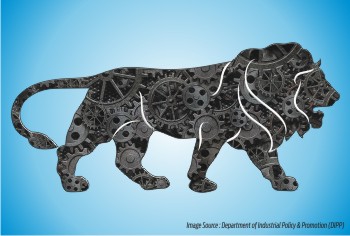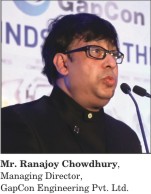India’s manufacturing activity is poised for significant growth under ‘Make in India’. Would the paper industry and associated enterprises fall inside the catchment area of this national program?
 Make in India is a major new national program envisaged by the Govt. of India to build a self-reliant manufacturing base in the country. To do so, the program articulates the facilitation of investment, protection of intellectual property, creation of best-in-class infrastructure across country, etc., which are essential components if a robust and vigorous manufacturing has to take place. The development of industrial clusters along identified industrial corridors, smart cities, youth based programs for skill enhancement, etc. are also being considered as the part of the program.
Make in India is a major new national program envisaged by the Govt. of India to build a self-reliant manufacturing base in the country. To do so, the program articulates the facilitation of investment, protection of intellectual property, creation of best-in-class infrastructure across country, etc., which are essential components if a robust and vigorous manufacturing has to take place. The development of industrial clusters along identified industrial corridors, smart cities, youth based programs for skill enhancement, etc. are also being considered as the part of the program.
In this background, one can conjecture that India’s manufacturing infrastructure and capacity for innovation are poised for phenomenal growth if the above conditions are met substantially. Paper Mart, buoyed by the response of previous chapter of ‘Make in India’ series based on manufacturers’ views, has decided to take up the suppliers’ standpoint this time.
To assess the program’s impact on the suppliers to pulp and paper industry and also to know their perspective on the growth of pulp and paper industry, we have arranged few questions for the representatives of the key suppliers to the pulp and paper industry. The answers would surely serve the purpose of better understanding of the program per se, and its effect on the growth of pulp and paper industry, not to say the growth of suppliers to this industry.
Let’s hear what they have to say on this initiative.
 Paper Mart: ‘Make in India’ is a spirited and zealous attempt on the part of the Govt. of India for laying strong manufacturing foundation in the country. Does this program signify much in terms of real manufacturing growth to take place?
Paper Mart: ‘Make in India’ is a spirited and zealous attempt on the part of the Govt. of India for laying strong manufacturing foundation in the country. Does this program signify much in terms of real manufacturing growth to take place?
Datta Kuvalekar: The Make in India campaign is a well intentioned campaign. To ensure that it succeeds, mere visibility and advertising campaigns won’t be adequate. What we need here are measures to boost consumer confidence that will spur industrial investment climate bolstered by ground level changes in Finance, Land, and Labor policies.
India needs to make real changes in its infrastructure (although much progress has happened over the decade) and investors need to experience the ease of conducting business in India. The focused Make in India campaign holds out a lot of promise, but without quick supporting/enabling mechanisms, it may not result in the expected investments.
PM: Does ‘Make in India’ program augers well for the growth of Indian pulp and paper industry?
DK: The growth of Indian pulp and paper industry is dependent on many factors –ranging from demand for various grades of paper to manufacturing climate for paper industry. The hindering factors that hold back paper industry from rapid expansion include availability of cost effective raw material, labor policies, land acquisition for plantations, and mills.
I would suggest that captains of Indian paper industry should list out their hindering factors which must get due attention from the State and Central Governments and rather quickly for the Slogan “Make in India” to become a trigger for Indian paper industry.
PM: What role do you see for yourself if a robust manufacturing of pulp and paper is to take place on account of this program?
DK: We do sincerely hope that Make in India brings good cheer to the pulp and paper industry. This will see major rebuilds and new green field and brownfield projects. As Forbes Marshall, we can support the Industry in terms of engineering their projects from a perspective of energy efficiency, safety and productivity based on our business domain of utility management and instrumentation.
Increased rebuild and project activity needs our products and services –ranging from Steam products like biomass boilers; steam distribution accessories like pressure reducing valves and steam traps; condensate pumps, paper machine steam, and condensate systems; hoods and pocket ventilation systems to control instrumentation systems like Quality Control Systems, DCS systems, flow/level/vibration and other process parameter measuring sensors.
Given the focus on environment both in water and air, we have a complete package for pulp and paper environmental monitoring. We have recently invested in a Mega factory that has capacity to meet the surge in demand resulting from an enhanced investment climate. This factory received the award for being the most well designed factory in India and we have designed it for the superior quality that Forbes Marshall is now synonymous for.
PM: As a key supplier to pulp and paper industry, would you be seeing a growth spurt in your own enterprise because of this program?
DK: Indeed, an enhanced investment in pulp and paper industry would see a positive impact on our paper business vertical. We have built enough engineering and manufacturing capacity to support this expected spurt in paper industry.
PM: If we consider your industry in general, does ‘Make in India’ target it directly through policies and incentives? What are the key challenges you think your industry is facing and which you prefer to get addressed through such national programs?
DK: Our industry is largely based on delivering energy savings and productivity improvements to our clients through our services and products. The Make in India campaign can enhance this through enabling guidelines of energy efficiency and environmental norms for production plants.
While our philosophy of business growth does not hinge on government policies or programs, as we are constantly walking into customer plants, we can only wish that Make in India enables our clients to expand rapidly and that will have a cascading effect on our business. From an operational perspective, the implementation of GST and Infrastructure investments will make our cost and ease of doing business in India easier.
An area that can receive more thrust from such national programs is to focus on creating collaborative platforms for innovation, research and development among paper industry, academia, and technology suppliers. These platforms can focus on three major issues of the paper industry- Energy, Environment, and Raw materials. We are very open to participating in active collaborative networks to help the paper industry become more sustainable.
.
 Paper Mart: ‘Make in India’ is a spirited and zealous attempt on the part of the Govt. of India for laying strong manufacturing foundation in the country. Does this program signify much in terms of real manufacturing growth to take place?
Paper Mart: ‘Make in India’ is a spirited and zealous attempt on the part of the Govt. of India for laying strong manufacturing foundation in the country. Does this program signify much in terms of real manufacturing growth to take place?
Ranajoy Chowdhury: The “Make in India” vision is laudable. It is a fact that the world is fast evolving with rebalancing of the manufacturing activities weighing across the developed and developing economies. Since China is fast losing its sheen with increasing costs, India has to capitalize with its robust domestic growth in demand, human resources and a strong base of entrepreneurs. India’s manufacturing sector is a classic example of an Industry that has the potential, but has been plagued with perhaps political ineffectiveness and entrepreneurial myopia.
“Those who cannot remember the past are condemned to repeat it”, hence it is important in order to legitimize the vision, and the Government should review the past issues, reviewing the same. The stage it seems is set, with the cited efforts of the Government, for India to transform its manufacturing ethos and seek global leadership.
PM: Does ‘Make in India’ program augers well for the growth of Indian pulp and paper industry?
RC: ‘Make in India’ campaign would be at loggerheads with the ‘Make in China’ idea that has gained momentum over the past decade. China is a major rival to India when it comes to the outsourcing, manufacturing, and services business specific to pulp and paper, though it is ahead of India big time when it comes to paper machinery, with most of the major European players already sitting on an established infrastructure. I believe that a well designed and consorted effort, in line with the vision, would fuel the much needed growth in the Indian pulp and paper Industry.
PM: What role do you see for yourself if a robust manufacturing of pulp and paper is to take place on account of this program?
RC: India is a country rich in natural resources. Labour is a plenty and skilled labour is easily available, given the high rates of unemployment among the educated class of the country. With Asia developing as the outsourcing hub of the world, India is soon poised to become the preferred manufacturing destination of most investors across the globe.
GapCon is the first European company, who has realized the significance of India as a future manufacturing hub for the world and had accordingly planned and executed its investments with a state of art infrastructure near Kolkata. The objectives were to create a catalyst that directly trigger a growth in paper manufacturing sector in India, with cost effective capital technology, knowledge and services tagged with “Made In India”, with German precision and know-how. It is envisaged that the cited infrastructure would be utilized not only by Indian paper mills, but paper manufacturing industries from all over Asia.
PM: As a key supplier to pulp and paper industry, would you be seeing a growth spurt in your own enterprise because of this program?
RC: GapCon believes that its present investment in India is the tip of the iceberg with more to come both short and medium term. We are bullish that GapCon’s investments would not only create a demand for technology and corresponding growth in the medium and smaller paper mills, which still by far remains the backbone of paper manufacturing in India, but also encourage foreign investments in the machinery manufacturing. The indications are already there that the ensuing growth of GapCon in India would benefit Indian paper manufacturing units and their economies of scale when it comes to investments in technology.
PM: If we consider your industry in general, does ‘Make in India’ target it directly through policies and incentives? What are the key challenges you think your industry is facing and which you prefer to get addressed through such national programs?
RC: In general, India’s ailing infrastructure scenario and defunct logistics facilities make it difficult for the country to achieve an elite status as a paper manufacturing hub in quick time. The bureaucratic approach of governments, lack of robust transport networks, inept labour laws and corruption make it difficult for paper and machinery manufacturers to improve bottom lines. This probably explains lack of any growth and recognized investments in paper machinery sector in India. The government presumably is committed to remove these hurdles and make the nation an ideal destination for investors to set up industries both paper manufacturing and its allies specific to machinery.
Facilitation of FDI both in paper manufacturing and paper machine manufacturing becomes paramount to the envisaged growth to neutralize the high cost of investments in India.
.
 Paper Mart: ‘Make in India’ is a spirited and zealous attempt on the part of the Govt. of India for laying strong manufacturing foundation in the country. Does this program signify much in terms of real manufacturing growth to take place?
Paper Mart: ‘Make in India’ is a spirited and zealous attempt on the part of the Govt. of India for laying strong manufacturing foundation in the country. Does this program signify much in terms of real manufacturing growth to take place?
Devesh Khaitan: These are exciting times in India from economic growth and rapid development point. Last year was marked by number of remarkable initiatives from the government such as “Make in India”. This shows the commitment towards improving the business environment in India and making it the preferred destination for global foreign direct investment.
The program includes new initiatives aimed to foster investment and innovation and to build best-in-class manufacturing infrastructure.
There are reports that China with its rising wages and increasing cost of production is fast losing its cost advantage. Russia too is facing challenges in maintaining its competitiveness, with rising wages and geo- political issues. Whereas, US and Mexico are reclaiming their share of the global manufacturing pie due to decline in factor costs and rising productivity.
India in this global environment is starting from a position that is far from advantageous. India’s manufacturing sector with a 15 percent share of overall GDP does not fare well when compared to its peers like Malaysia, Thailand and Indonesia. India also suffers from the lack of infrastructure, poor perception in terms of ease of doing business and a lack of proven ability to compete at a global scale. However, India’s long term prospects remain intact with its core strength of human resource, a strong base of entrepreneurs and a growing domestic demand.
In many ways, therefore, the stage is set for India to transform its manufacturing and seek global leadership.
PM: Does ‘Make in India’ program augurs well for the growth of Indian pulp and paper industry?
DK: The program might not necessarily be directly supporting the paper industry, but the basic requirement would be improved thereby, increasing the bottom line. Lot of focus would be made on Infrastructure, due to which at this present moment paper industry incurs extra cost, which could be brought down or saved.
The program in full swing, we might even see more acquisitions from overseas players which would ultimately lead to cost competitiveness in the industry. This looks possible since all the demand drivers and growth factor for paper industry are in place like, higher government spending on education sector, more packaging and branding requirement and higher urbanization. In view of these drivers packaging and specialty papers like tissue are poised for a higher growth trajectory in future.
PM: What role do you see for yourself if a robust manufacturing of pulp and paper is to take place on account of this program?
DK: More responsibility for the paper industry i.e. manufacturing more of value added products and services for the paper industry in India. At present paper industry imports lots of equipment and services. By making these available in India, the cost and the delivery time could be brought down. However, we feel the level and quality of services would be a major differentiator as ease of availability of technology increases. This would mean we would need to increase skill and competence level at a rapid pace.
PM: As a key supplier to pulp and paper industry, would you be seeing a growth spurt in your own enterprise because of this program?
DK: In view of the nature of our product and service offerings, we have a natural stake in the growth of the paper industry. Obviously, as more opportunity comes our way, we will have to harness them for our growth. In view of this, we may find that overseas suppliers of our products and services may think of investing through local partners and be a part of growing paper industry. As mentioned above, with increased skill and competence level overseas companies can also use us as a hub for huge paper industry in Asia.
PM: If we consider your industry in general, does ‘Make in India’ target it directly through policies and incentives? What are the key challenges you think your industry is facing and which you prefer to get addressed through such national programs?
DK: Each and every industry is and will keep facing challenges and the paper industry is no exception. Policies and incentives do play a role, but an Industry cannot just depend on them. We ourselves have to find the right path and solutions. There are obvious challenges in paper industry like raw material availability, investment, technology up gradation, etc., but we tend often overlook issues related to industry image, manpower availability, mindset, etc.
Paper industry is a capital intensive industry i.e. technology needs to be updated continuously for quality and cost competitiveness. Unfortunately, there is no shortcut to this. The mills that do not have global quality standards and cost competitiveness would soon lose out on the market in the future. We, too, as paper machine clothing manufacturers fall in the same line as paper industry as we also need to upgrade our technology and machinery frequently just to be in business and match accepted international standard.
Our company’s global footprint in over 20 countries is a result of this philosophy only. Of course, this does affect the margin, but there is no shortcut to it. Lack of skilled manpower and attracting good talent to paper industry are issues which should be taken very strongly by the leaders and the captains of the industry. Unless we improve the image of our industry we will always find it difficult to attract and retain good people. So, there is a very strong need to find ways of changing this mindset. We ourselves have to get together and solve this issue, or else our goal of becoming a major paper producing country may remain on paper only…. pun purely intended.
.
 Paper Mart: ‘Make in India’ is a spirited and zealous attempt on the part of the Govt. of India for laying strong manufacturing foundation in the country. Does this program signify much in terms of real manufacturing growth to take place?
Paper Mart: ‘Make in India’ is a spirited and zealous attempt on the part of the Govt. of India for laying strong manufacturing foundation in the country. Does this program signify much in terms of real manufacturing growth to take place?
Shekhar Desarada: Yes, given the fact that we are neither short of intellect nor enterprise. This program would help in driving out our innate affinity for volume over value and price over performance and help stand India on par with the most developed nations across the globe.
PM: Does ‘Make in India’ program augers well for the growth of Indian pulp and paper industry?
SD: Yes, it would give a lead for the Indian manufacturers serving this most volatile sector which today contributes Rs. 25 billion to the exchequer employing 1.5 million people and is the 15th largest in the world, as per the information available on the internet. Recently, the Government has regarded paper industry as one of the 35 high priority industries of the country for growth and development.
Growth of paper industry in India has been constrained due to high cost of production caused by inadequate availability and high cost of raw materials, power cost and concentration of mills in one particular area. The Government has taken several policy measures to remove the bottlenecks of availability of raw materials and infrastructure development. For example, to overcome short supply of raw materials, duty on pulp and waste paper and wood logs/chips has been reduced. Outlook for paper industry in India looks extremely positive as the demand for upstream market of paper products like tissue paper, tea bags, filter paper, light weight online coated paper, medical grade coated paper, etc., is growing up.
PM: What role do you see for yourself if a robust manufacturing of pulp and paper is to take place on account of this program?
SD: PARASON foresees for itself a vital role for a robust manufacturing to take place in the pulp and paper industry. Our company has proven track record of more than three decades (35 years) for supplying pulp making machinery and spare parts. We are equipped with most modern and sophisticated manufacturing facilities backed with a research and development centre for metallurgy approved by the Ministry of Science and Technology, the Govt. of India. Our strength to export to more than 52 countries across the globe reflects our worthiness of a vital role in this “Make in India” program.
PM: As a key supplier to pulp and paper industry, would you be seeing a growth spurt in your own enterprise because of this program?
SD: Our role is to serve the customers with latest in pulp and paper technology with efficient and power saving equipment manufacturing which are, at the same time, cost effective also and on par with world class technology. There is a need to inculcate culture of innovation to redefine the market place. We should not limit ourselves to redefining the market share with disruptive innovation. The process of innovation should apply to every aspect of business- not only product, but packaging, promotion and customer service also.
PM: If we consider your industry in general, does ‘Make in India’ target it directly through policies and incentives? What are the key challenges you think your industry is facing and which you prefer to get addressed through such national programs?
SD: Reluctance to accept the high end technologies and pursue with the age old technologies are making the paper industry more power consuming Industry. It is need of the time for them to move towards redefining ROI to be Return on Innovation instead of Return on Investment.
The most dreaded challenge is to make the Industry more environment friendly with infusion of most efficient technological ways to tackle the pollution.
It is also required to breed innovation at grassroots level which will help us to combat competition from China on the global market front.
I would emphasize that the Government needs to consider a professional academic course in the main stream of regular education related to pulp and paper making. This will help in building up a responsible pool of qualified human resources. This talented pool will bring innovations to the industry. The Governmet should incentivize the innovation and also devise methods of protecting it.



